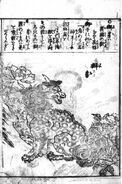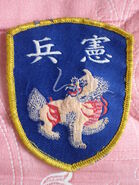
Xiezhi (Chinese: 獬豸) or zhi (廌) is a Chinese legendary creature, which looks like a goat with a single horn on its forehead. It can by nature distinguish the innocent from the guilty and punishes the latter, piercing them with its horn.[1] Gao Yao, the minister of justice in the court of Emperor Shun, was said to have a xiezhi and use it in criminal proceedings, whenever he was in doubt about the guilt of the suspect.[2]
King Xuan of Qi once asked his minister Ai Zi about the xiezhi. The sage answered that it was a sacred animal kept in the Imperial Court in ancient times. When it saw a corrupt official, it pierced him with its horn and devoured. "If such animal lived today", he added, "it would not need to go hungry."[3]
According to Shuowen Jiezi, xiezhi looks like an ox with a single horn. The dictionary also mentions the animal in the definition of the 薦 jiàn character, which is composed of 艸 (grass) and 廌 (zhi). An ancient deity once gifted a xiezhi to Huangdi, the Yellow Emperor. The ruler asked: "What does it eat? Where does it live?" The deity answered: "It eats jian-grass. In summer, it lives in marshy areas. In winter, it stays where evergreens and cypresses grow."[4]
Xiezhi and the law[]

Xiezhi rank badge
Xiezhi is regarded in East Asia as an allegory of legal justice. In the Ming and Qing Dynasties, a picture of a xiezhi was on the official badge of government censors, whose job was to seek out corruption and maintain discipline among other court officials.[5] The character "law" in Chinese – 法 fǎ – is a simplification of earlier 灋 fǎ, which is a compound of 水 (water), 廌 (zhi) and 去 (to remove, to avoid). This shows how in Ancient China xiezhi was integral to the concept of law.
Name[]
The name of the animal is one of the oldest words in the Chinese language. Like all words, it was originally monosyllabic and represented by a single pictogram 廌 or 𢊁 (pinyin: zhì). However, as the vocabulary of the Chinese language grew, single syllable-words became too ambiguous and polysyllabic compounds started to be used to express the same ideas. The Chinese called the creature 獬廌 (xièzhì, also written as 觟𧣾) or 解廌 (jiězhì).[4] The original pictogram was in time simplified to 豸 (zhi; could also mean "worm"). Another name for the Xiezhi is 神羊 (shényáng), which means "divine goat".
In Korea, the creature's name is haetae (해태) or haechi (해치). The Japanese use the same kanji as the Chinese, but pronounce the names kaichi (獬豸, alt. kai-tsi, cai-zhi) and shin'yō (神羊, alt. sin-you).
Gallery[]
References[]
- ↑ Yang Fu, Yiwu Zhi
- ↑ Wang Chong, Lunheng
- ↑ Su Shi, Ai zi zashuo
- ↑ 4.0 4.1 Jeannie Parker, The Mythic Chinese Unicorn, ch. 4
- ↑ Pacific Asia Museum, Rank and Style: Power dressing in Imperial China, Section 1



